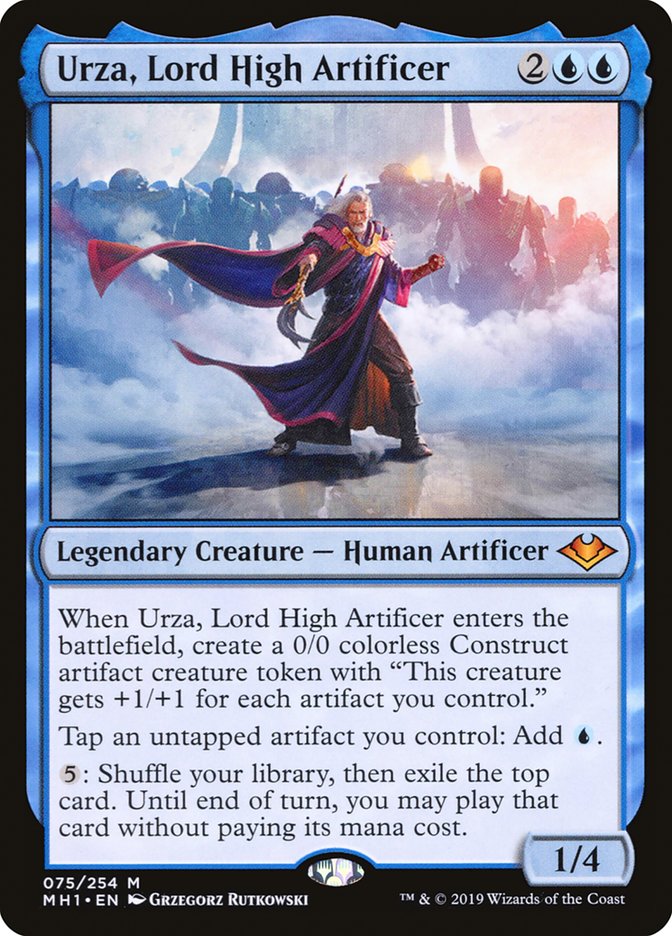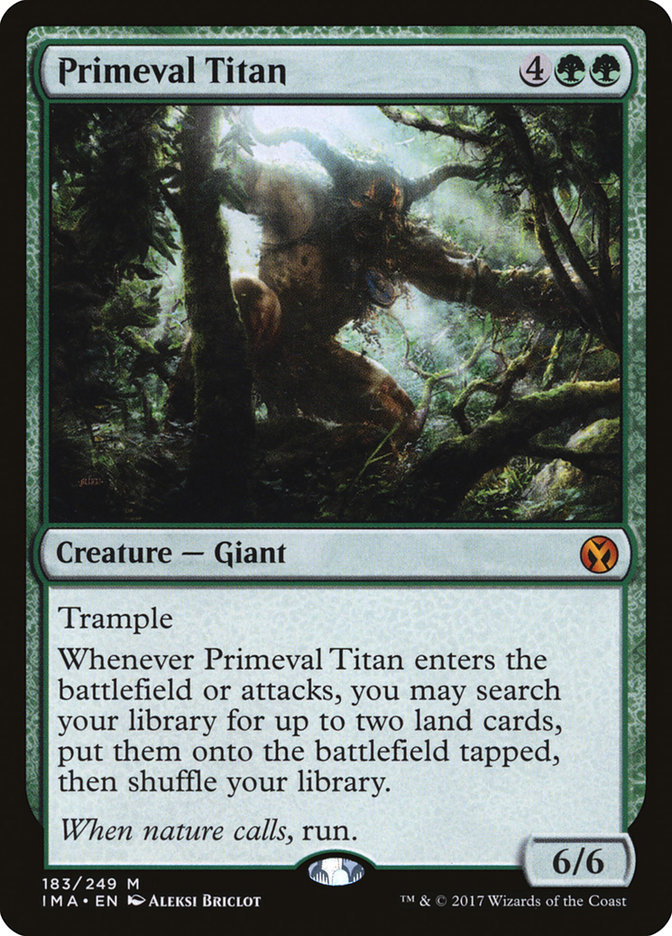Welcome back to another Mox Insights breakdown on the SCG Tour! We’re ready to explore how Day 2 of SCG Atlanta broke down and trace how Grixis Death’s Shadow emerged on top, wrestling with the Simic Whirza deck from Team Lotus Box.
Sixteen Angles (on the Format)
Going into SCG Atlanta, Urza, Lord High Artificer and Oko, Thief of Crowns were fast becoming best friends. Oko, Thief of Crowns started as a sideboard support, but two weeks later, he was the most popular planeswalker in the room.
|
Event |
Maindeck |
Sideboard |
Total |
|
SCG Indianapolis |
10 |
54 |
64 |
|
SCG Atlanta |
90 |
23 |
113 |
That’s almost a 200% increase in the amount of play Oko saw, and he proved himself to be a maindeck all-star when people leaned into playing him in their maindeck. Among those decks that played Oko main, they saw their win rate go up ten points compared to those who maindecked Oko at SCG Indianapolis.
|
Event |
Wins |
Losses |
Draws |
MWP (match win percentage) |
|
SCG Indianapolis |
20 |
21 |
1 |
48.4% |
|
SCG Atlanta |
158 |
108 |
12 |
58.3% |
We want to note that the higher number of draws in Atlanta can mostly be attributed to players in the last round of the tournament drawing into their final standings.
Just like last week, the more copies of Oko in players’ 75, the better:
|
Event |
Wins |
Losses |
Draws |
MWP |
|
SCG Indianapolis |
124 |
101 |
3 |
54.8% |
|
SCG Atlanta |
219 |
153 |
17 |
57.8% |
So, how do these Oko, Thief of Crowns decks relate to the rest of the metagame? Here’s the breakdown of SCG Atlanta in the Top 16 most-represented archetypes on Day 2.
| Amulet Titan | 1-3 | 2-8 | 3-0 | 5-0 | 3-3 | 5-0 | 2-2 | 2-1 | 2-3 | 3-0 | 1-4 | 2-2 | 1-3 | 0-1 | – | |
|---|---|---|---|---|---|---|---|---|---|---|---|---|---|---|---|---|
| Simic Whirza | 3-1 | 3-2 | 5-2 | – | 5-1 | 1-2 | 1-0 | 3-0 | 6-4 | 4-2 | – | 3-0 | 1-1 | 1-1 | – | |
| Four-Color Whirza | 8-2 | 2-3 | 3-0 | 1-1 | 3-0 | 0-2 | 3-1 | 1-0 | – | 2-1 | 1-2 | 1-3 | 2-0 | 1-2 | 1-0 | |
| Mono-Green Tron | 0-3 | 2-5 | 0-3 | 1-1 | 0-1 | 1-2 | 1-1 | 3-0 | – | 0-1 | – | 0-2 | 1-1 | 1-0 | 2-0 | |
| Burn | 0-5 | – | 1-1 | 1-1 | 1-4 | 0-2 | 3-1 | 1-1 | – | 2-3 | 0-1 | 0-1 | 0-2 | 2-0 | 2-1 | |
| CrabVine | 3-3 | 1-5 | 0-3 | 1-0 | 4-1 | 4-0 | 3-1 | 2-2 | 2-2 | 1-1 | 1-1 | 0-1 | 2-2 | 1-0 | 1-0 | |
| Grixis Death’s Shadow | 0-5 | 2-1 | 2-0 | 2-1 | 2-0 | 0-4 | 2-0 | 0-1 | 1-0 | 1-0 | 2-2 | 2-0 | 1-0 | – | 4-0 | |
| TitanShift | 2-2 | 0-1 | 1-3 | 1-1 | 1-3 | 1-3 | 0-2 | 3-0 | 1-2 | 0-4 | – | 0-3 | – | – | 1-0 | |
| Eldrazi Tron | 1-2 | 0-3 | 0-1 | 0-3 | 1-1 | 2-2 | 1-0 | 0-3 | 1-0 | – | 1-1 | – | – | 1-2 | 0-1 | |
| Urza Midrange | 3-2 | 4-6 | – | – | – | 2-2 | 0-1 | 2-1 | 0-1 | 1-0 | 1-0 | 1-0 | 0-1 | – | – | |
| Jund | 0-3 | 2-4 | 1-2 | 1-0 | 3-2 | 1-1 | 0-1 | 4-0 | – | 0-1 | – | 0-1 | 1-1 | 1-0 | 0-1 | |
| Four-Color Death’s Shadow | 4-1 | – | 2-1 | – | 1-0 | 1-1 | 2-2 | – | 1-1 | 0-1 | – | – | 1-1 | – | 1-0 | |
| Infect | 2-2 | 0-3 | 3-1 | 2-0 | 1-0 | 1-0 | 0-2 | 3-0 | – | 0-1 | 1-0 | – | – | 0-2 | – | |
| Affinity | 3-1 | 1-1 | 0-2 | 1-1 | 2-0 | 2-2 | 0-1 | – | – | 1-0 | 1-1 | 1-1 | – | – | 0-1 | |
| Jund Death’s Shadow | 1-0 | 1-1 | 2-1 | 0-1 | 0-2 | 0-1 | – | – | 2-1 | – | 0-1 | – | 2-0 | – | – | |
| Azorius Control | – | – | 0-1 | 0-2 | 1-2 | 0-1 | 0-4 | 0-1 | 1-0 | – | 1-0 | 0-1 | – | 1-0 | – | |
|
Amulet Titan
|
Simic Whirza
|
Four-Color Whirza
|
Mono-Green Tron
|
Burn
|
CrabVine
|
TitanShift
|
Eldrazi Tron
|
Urza Midrange
|
Jund
|
Four-Color Death’s Shadow
|
Infect
|
Affinity
|
Jund Death’s Shadow
|
Azorius Control
|
| 80 | |
| 70 | |
| 60 | |
| 50 | |
| 40 | |
| 30 | |
| 20 |
Right now, it is unequivocal: Urza, Lord High Artificer and Oko, Thief of Crowns are the two most important cards that anyone is going to encounter playing on the SCG Tour. Compared to SCG Indianapolis, we’re starting to see a more refined SCG metagame develop, particularly around the innovative Simic Whirza deck from Team Lotus Box – the same that put three copies into the Top 8. It boasted positive matchups against most of the top decks that made Day 2, Grixis Shadow being a minor outlier, which we’ll talk about shortly.
While we classified the Urza Midrange decks separately per the decklists provided to SCG on Day 2, we want to note that “Urza Midrange” is an extremely close cousin to the Simic Whirza decks, usually a couple of cards off from the Simic Whirza Lotus Box build. In a way, this definitional clustering makes the Simic Whirza decks look slightly better, since they performed that much better compared to the Urza Midrange players, even though those Urza Midrange players were also positive against the field. In fact, every deck that played Urza, Lord High Artificer was positive against the field.
They were especially positive against Amulet Titan, the most popular deck in Day 2 and a deck that did mostly well, outside of the Urza matchups, where it went a combined 36% match win percentage against those decks. It’s the decks outside of Urza where Amulet Titan did well, where it trounced Mono-Green Tron, Burn, and Grixis Death’s Shadow. Amulet Titan’s weaknesses were as you might have anticipated: Affinity and Infect, especially since Amulet Titan has trimmed on interaction, leaning more into a consistent combo build with Once Upon a Time.
Of the most popular four decks, Mono-Green Tron was the biggest loser. Simic Whirza decks in particular were prepared to swing what had been a difficult matchup at SCG Indianapolis with Damping Spheres and countermagic. We have to ask: what is the Mono-Green Tron player preying upon that makes Mono-Green Tron a strong deck choice? Azorius Control and Jund are not enough.
Creatures (29)
- 4 Narcomoeba
- 4 Hedron Crab
- 4 Vengevine
- 4 Gravecrawler
- 1 Gurmag Angler
- 4 Prized Amalgam
- 4 Stitcher's Supplier
- 4 Merfolk Secretkeeper
Lands (19)
Spells (12)
Sideboard

CrabVine was the fifth-most-popular deck, which was a new player to the field. Powered up by Merfolk Secretkeeper, this is a deck that you should keep an eye on. The high blue count of the deck allows Force of Negation to be a sideboard option in fighting graveyard hate. Time will tell if CrabVine can be a strong heir to or replacement for Dredge or if CrabVine was successful only through the asymmetry of information and relatively minimal amount of graveyard hate that players are currently running, since Urza decks have moved away from focusing tightly on the Thopter Foundry / Sword of the Meek combo and utilize Paradoxical Outcome.
Which leaves us with the last major archetype: Grixis Death’s Shadow and Four-Color Death’s Shadow, and how they relate to Urza, Lord High Artificer decks.
Some Kind of Wonderful (Metagame Call)
Grixis Death’s Shadow won the tournament and looked capable as it won the semifinal and final rounds in the hands of hometown hero John Holland. And, on the whole, these decks did do well in Day 2 against the Urza decks:
|
Archetype |
Wins |
Losses |
Draws |
MWP |
|
Four-Color Death’s Shadow |
3 |
2 |
0 |
60% |
|
15 |
5 |
1 |
73% |
|
|
Jund Death’s Shadow |
8 |
5 |
1 |
60% |
However, we wanted to adjust and focus specifically on the Simic Whirza and Urza Midrange archetypes, these new builds that are making countermagic and Oko, Thief of Crowns a central part of their plan. When you look at those alone with Four-Color Death’s Shadow and Urza Midrange/Simic Whirza, the matchup looks a lot more even, closer to 50-50. Now, that sample size itself is extremely small, so we don’t want to draw hugely out-of-proportion conclusions from it, but the Simic Whirza decks are not a bye for Death’s Shadow players and they should not take them lightly. We recommend building more Engineered Explosives into your Death’s Shadow sideboards as effective ways to fight Food tokens.
Play Anything (As Long As There’s Oko)
When you start to look at the Urza and Oko decks against the field, we start to see a metagame where a couple of decks are pulling away from the rest of the field:
First off, simply playing an Urza deck correlates with tournament success. Simic Whirza as a whole clearly owes a lot of its strength to the talent of the players who took it to the tournament, but it also is an extremely strong deck that is leveraging massive amounts of resources in every game. Even the supposed better performance of the consistent Four-Color Whirza builds against Simic Urza wasn’t borne out on Day 2, as Simic Whirza went 3-2 against Four-Color Whirza.
|
Archetype |
Wins |
Losses |
Unintentional Draws |
MWP |
|
Simic Whirza |
49 |
19 |
2 |
71% |
|
Four-Color Whirza |
37 |
21 |
2 |
63% |
Against the field, Simic Whirza still performed better than Four-Color Whirza. Are we seeing the end-game development of Urza decks? We look forward to seeing further iterating on the Simic Whirza builds. Expect it to be a powerful player going into the Season Two Invitational and the Players’ Championship.
Food for Thought
Next time you hear from us, we’ll be discussing SCG CON Winter and the Season Two Invitational. Pioneer is already shaping up to be a surprisingly fair format that we’re excited to explore over the course of the Invitational and coming Opens as the metagame begins to move. Until then, this has been your Mox Insights!




